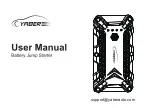
GUIDE TO INSTALLATION AND OPERATION
4
| RCP-100
Ethernet
Use this RJ-45 female connector to connect the RCP-100 to a Local Area Network (LAN) using common
10BASE-T cables. The LED next to the RJ-45 connector will turn on to indicate network activity.
AC IN
The RCP-100 features a universal power supply. Connect the supplied AC power cord to the AC IN
connector on the rear panel.
3.4 Networking
Considerations
The RCP-100 has two means of accessing devices which it can control:
3.4.1 Serial
Port
Connection
All imaging frame rear panels (except the Quartet base model) include 2 identical RS-422 ports which may
be used interchangeably as the source or as a daisy chain loop-through. These ports enable communication
between a series of imaging frames and the RCP-100. Remember that the last frame in a daisy chain
requires a termination. Figure 3.3 gives an example of a daisy chain hook-up. Refer to the imaging frame’s
Guide to Installation and Operation for details on daisy chain installation and cable construction.
Figure 3.3
Daisy chain installation example
RS-422 Serial ID Assignment
In order for an RCP-100 to control the cards in a daisy-chain of frames, the RCP-100 must be able to identify
and access each frame individually. The only way to accomplish this is to assign an identification code to
each member of the daisy chain. This is similar to assigning different addresses to buildings on a street.
Refer to the imaging frame’s Guide to Installation and Operation for details on how to set these ID codes.
3.4.2 Ethernet
Connection
The RCP-100 can connect to a LAN through its ethernet port, and control those devices which have been
specified in the directory files. At present, RCP-100 supports the Miranda Densité series of frames and
cards, when they are equipped with an ethernet controller card (ETH-CPU). It is also possible to order an
RCP-100 configured specially to operate Miranda's Aquila series of upconverters; such panels will not control
other Miranda devices.
From the software point of view, RCP-100 contains three separate modules: (1) Client, (2) Directory
Services, and (3) serial/ethernet Communications and Services. All three of these modules are required to
be present on the LAN, and each could run separately on a different RCP-100, which would communicate
among themselves using the TCP protocol. However, in most situations, there are only two practical
configurations for an RCP-100:









































